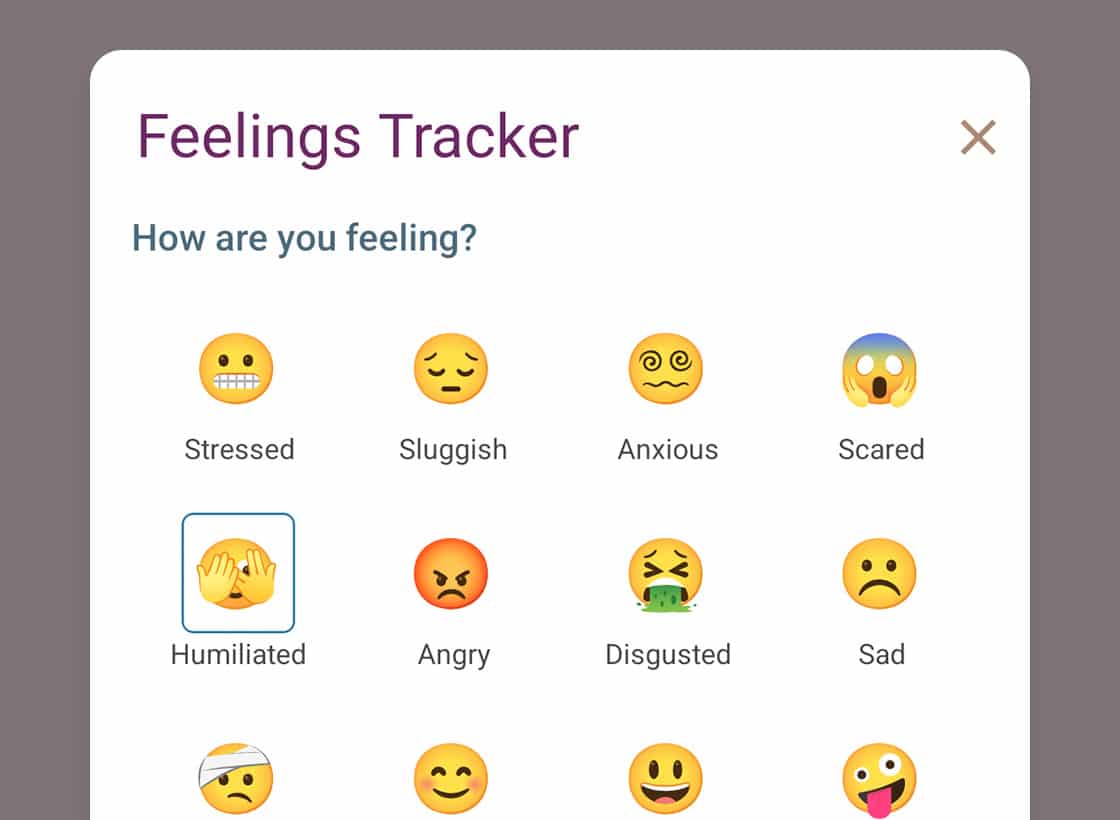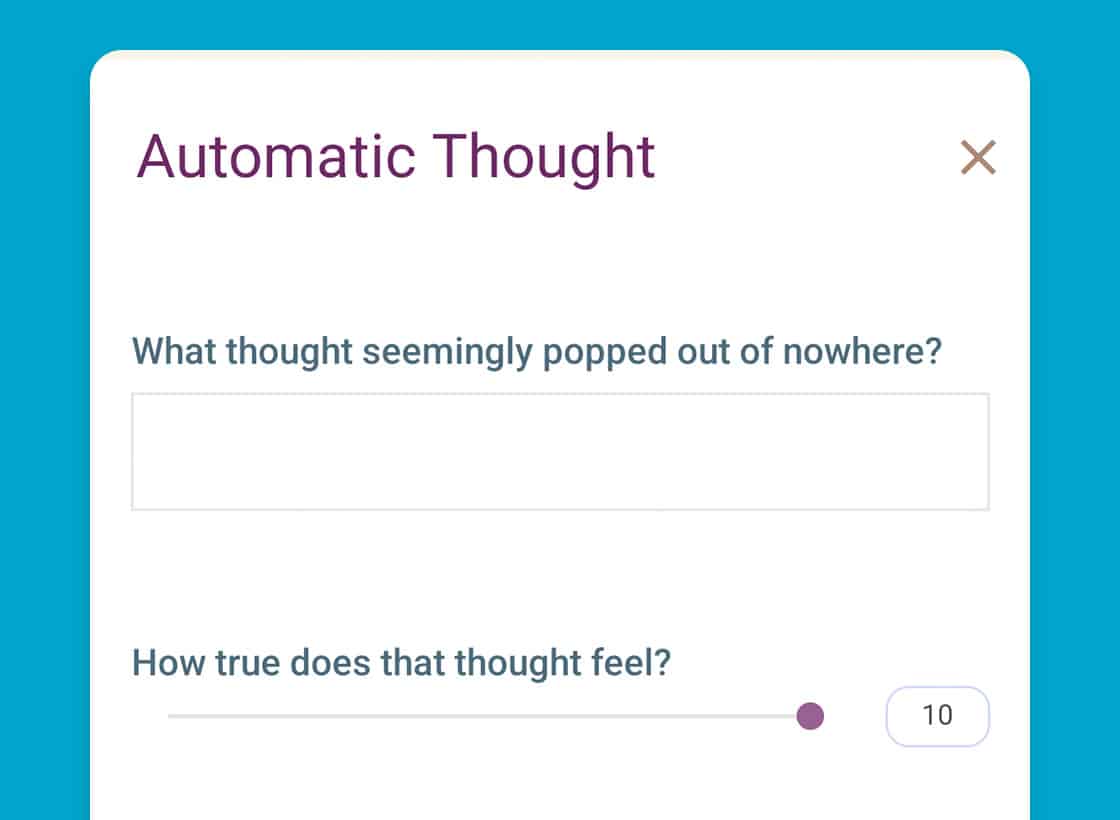Get the enhanced Feelings Tracker
Template by Reflective
Best for OCD Anxiety Depression CBT DBT ACT Solution Focused
The new Feelings Tracker is designed to help clients identify and articulate their emotions. By encouraging individuals to label their feelings and express the reasons behind them, this tracker fosters greater emotional awareness and expression. As therapists, integrating the Feelings Tracker into your practice can enhance your clients’ ability to understand and manage their emotions. By utilizing the Feelings Tracker, you can facilitate more effective therapeutic sessions, promote self-awareness, and empower clients to navigate their emotional experiences with greater clarity and confidence.
Get Feelings Tracker worksheet in the Reflective app
Share the Feelings Tracker worksheet with your patient with the Reflective app. Simply enter their email, and they’ll be able to fill in the worksheet from the convenience of their phone. Get started for free!
How does Reflective work?
Share exercise with client via Reflective
Client receives email with app link and connection request
Client clicks link to download app
Client accepts your connection and exercises you shared
Client uses app to fill in exercises, gets reminders
What is a Feelings Tracker?
A Feelings Tracker is a therapeutic tool designed to help clients increase their awareness and understanding of their emotional experiences. By identifying and rating their feelings on a regular basis, clients can better understand their emotional patterns, triggers, and the intensity of their emotions. This tool can be especially helpful in therapy, as it provides both the client and therapist with valuable insights into the client’s emotional state over time, facilitating more targeted and effective interventions.
What’s the Difference Between “Feelings” and “Moods”?
Understanding the distinction between feelings and moods is essential in utilizing a Feelings Tracker effectively. Feelings are typically short-lived emotional responses to specific events or stimuli. For example, a client might feel “angry” after an argument or “happy” after receiving good news. Moods, on the other hand, are more prolonged and less specific emotional states that can last for hours, days, or even longer. While a feeling is usually tied to a particular event, a mood may persist without an identifiable cause. A Feelings Tracker focuses on these shorter-term emotional experiences, helping clients to pinpoint and assess their immediate emotional reactions.
What Are Feelings Your Client Can Choose From?
In this version of the Feelings Tracker exercise, clients can choose from 12 unique feelings:
- Stressed: A state of mental or emotional strain or tension.
- Sluggish: A feeling of slow movement, low energy, or lethargy.
- Anxious: A sense of unease, worry, or fear, often about an upcoming event.
- Scared: A feeling of fear or apprehension, often in response to a specific threat.
- Humiliated: A feeling of shame or embarrassment, often from being belittled.
- Angry: A strong feeling of displeasure or hostility.
- Disgusted: A feeling of revulsion or strong disapproval.
- Sad: A feeling of sorrow or unhappiness.
- Lonely: A feeling of isolation or lack of companionship.
- Happy: A feeling of pleasure, contentment, or joy.
- Excited: A feeling of heightened enthusiasm or eagerness.
- Silly: A lighthearted, playful, or mildly foolish feeling.
How to Use This Exercise
Step 1: Select Feelings Tracker from the Template Library
Begin by selecting the Feelings Tracker template from your digital library or therapeutic toolkit. Ensure the template includes the 12 feelings mentioned above, along with a scale for intensity rating and space for journaling.
Step 2: Share with Your Patient
Once you have selected the template, share it with your patient. Depending on your practice, this could be a physical handout, a digital document, or an interactive online tool. Explain the purpose of the exercise and how it can help them better understand and manage their emotions.
Step 3: Familiarize Yourself with the Assignment
Before asking your patient to begin, review the exercise in detail yourself. Understand the range of feelings included, the rating scale, and the journaling component. This will prepare you to guide the patient through the exercise, answer any questions they might have, and interpret their responses effectively.
Step 4: Repeat as Needed
Encourage your patient to use the Feelings Tracker regularly. Depending on their needs, this could be daily, weekly, or whenever they experience a significant emotional event. Repeated use allows for a more comprehensive understanding of their emotional patterns and helps track progress over time.
The Benefits of Using a Feelings Tracker Exercise
The Feelings Tracker exercise offers several therapeutic benefits:
- Enhanced Emotional Awareness: Regular tracking helps clients become more attuned to their emotional states, recognizing feelings they might otherwise overlook.
- Identifying Patterns and Triggers: By documenting their feelings and the context in which they arise, clients can begin to identify patterns and triggers for specific emotions, leading to better management strategies.
- Improved Communication: The exercise provides a structured way for clients to communicate their feelings, making it easier for them to express emotions that might be difficult to articulate verbally.
- Empowerment and Self-Regulation: Understanding and tracking emotions empowers clients to take an active role in managing their emotional health, leading to better self-regulation and coping strategies.
- Insight for Therapists: For therapists, the Feelings Tracker offers valuable data on a client’s emotional experiences, enabling more targeted interventions and a deeper understanding of the client’s emotional world.
Incorporating a Feelings Tracker into therapy sessions can significantly enhance the therapeutic process, providing both the client and therapist with a clearer picture of emotional dynamics and progress over time.
Enhancing your Practice with Reflective: A Smart Approach to Client Engagement
Incorporating therapeutic exercises into your clients’ routines is a vital aspect of many evidence-based therapies. Reflective is designed to streamline this process, offering numerous benefits that can really enhance the therapeutic journey. Here’s how using Reflective can make a difference for both you and your clients.
Convenience and Accessibility
One of the standout benefits of using Reflective is the sheer convenience it offers. Most people are already glued to their smartphones, making it easier than ever to integrate therapy into daily life. With Reflective, your clients can access their therapy exercises anytime, anywhere, reducing the risk of forgetting to complete them. The platform’s user-friendly interface ensures that these exercises are always within reach, encouraging consistent practice and reinforcing the concepts discussed in therapy sessions.
Versatility Across Therapeutic Modalities
Reflective is not just for Cognitive Behavioral Therapy (CBT). While CBT traditionally emphasizes the importance of homework, Reflective’s versatility allows it to be effectively utilized across a range of therapeutic modalities. Whether you’re practicing Dialectical Behavior Therapy (DBT), Acceptance and Commitment Therapy (ACT), or other evidence-based approaches, Reflective provides a flexible tool to help your clients internalize and apply the concepts discussed in therapy. This adaptability makes it a valuable asset in any therapeutic setting.
Engaging Clients in Non-CBT Modalities
Even for therapeutic modalities that do not traditionally emphasize homework, Reflective can play a crucial role. Providing exercises outside of sessions helps clients to integrate the ideas and techniques discussed during therapy into their daily lives. This active engagement fosters a deeper connection to the therapeutic work and can lead to more significant, lasting changes. As an added bonus, adding content and exercises that uniquely represent your style as a therapist is a great branding opportunity, and helps prospects and clients connect with you.
Boosting Accountability
Accountability is a powerful motivator in therapy. With Reflective, clients know that you have the ability to review their submissions, even if you choose not to. This awareness can drive them to take their exercises more seriously, knowing that their efforts are being monitored. The potential for feedback adds an extra layer of responsibility, encouraging more diligent and reflective practice.
Creating Valuable Talking Points for Sessions
Finally, the submissions your clients make through Reflective can serve as valuable talking points during their therapy sessions. Whether they reference their mental health journaling or specific exercises they’ve completed, these reflections can lead to deeper insights and more focused discussions. This makes your sessions more personalized, constructive, and targeted, addressing the specific challenges or breakthroughs your client experienced during the week.
Reflective offers a smart, convenient, and versatile approach to integrating therapeutic exercises into your clients’ lives. By boosting accountability, supporting a variety of therapeutic modalities, and creating valuable opportunities for reflection and discussion, Reflective enhances the overall effectiveness of therapy, helping your clients achieve better outcomes.



